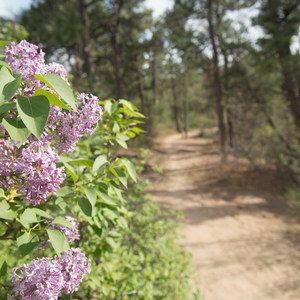You are here
Walking in the Eastern Colorado plains, it is hard to visualize the geological history under our feet. But at the Paint Mines Interpretive Park, millions of years of erosion have exposed many layers, with the deeper ones dating to 55 million years ago. This site offers wonderful views of clay and rock formations that capture that geological history, and they are accessible through a gentle 4-mile hike.
You can start the hike from the north parking lot, where there is a pit toilet, and the trail connects to the south parking lot. The west parking lot is a short walk away from a panoramic view of the site. The hike around the park is an easy 4 miles and mostly flat (some 600 feet of total elevation gain). It is possible to walk just short portions of the trail and admire the beautiful clay and rock formations. Do not climb them, however, as they are fragile and can also be dangerous. While the hike is easy, there is no shade or protection from the elements, so make sure to dress appropriately for the weather and bring sufficient water in the summer.
This area was a hardwood tropical forest 55 million years ago. That layer was later covered in white sandstone and several other layers over millennia. Wind and rain have eroded the stone and clay, resulting in beautiful formations showing shades of purple, orange, yellow, brown and white. Hoodoos –clay and rock towers- offer particularly interesting photo opportunities. Aside from its geological significance, the site is important for human history (and pre-history). Native Americans visited or inhabited this area for the last 9,000 years, and used colored clay and rocks to make pottery and tools, such as arrow heads.
Wildlife and vegetation are typical of the plains. Mammals include mule deer, pronghorn, coyotes, foxes, rabbits and rodents. There are many species of birds, including bald and golden eagles, owls, falcons and hawks (red-tailed being the most common, though Swainson’s hawks are present in the summer, and rough-legged and ferruginous hawks are more often seen in the winter). In August through September, rabbitbrush is in (yellow) flower, and is abundant in the site. Purple tansyaster is also common in late summer to early fall.
All in all, this makes a great day trip for the whole family, and it offers excellent photo opportunities as well as the chance to learn about the geological and archeological history of the Colorado Plains. Please refrain from climbing the formations so that future generations can also enjoy this wonderful location.







Comments
Sign In and share them.